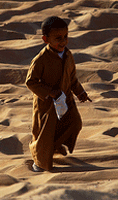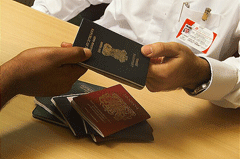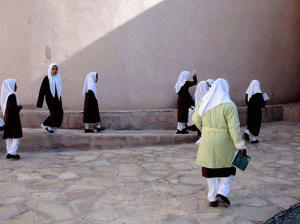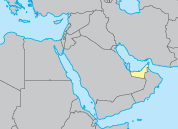Children of United Arab Emirates
Realizing Children’s Rights in United Arab Emirates


Founded on 2 December 1971, the United Arab Emirates (UAE) today consists of seven federated emirates. Its first president put the country on the path to modernization, investing oil profits in building hospitals, schools and housing. The UAE is among the richest countries in the world; nevertheless, despite all efforts, children’s and non-citizens’ rights remains a matter of concern. Abuse and access to education, especially for girls, remain sensitive issues.
Population: 5.4 million Life expectancy: 76,6 years |
Main problems faced by children in United Arab Emirats:
Discrimination against non-citizens
In the UAE, only about 825 500 people of the total population of over 5.3 million inhabitants have UAE nationality. In several reports, the United Nations have noted their concern about the fact that non-citizens in the UAE have limited access to basic rights, particularly with regard to access to health care and education.
Statelessness and the right to citizenship
 Conditions of access to citizenship in the UAE are very strict. Paternity prevails and only children born of UAE fathers can acquire UAE nationality at birth. Emirati women married to foreigners have no right to pass on their nationality. When such children are barred from acquiring the nationality of their fathers, they find themselves stateless and are therefore vulnerable to many rights violations.
Conditions of access to citizenship in the UAE are very strict. Paternity prevails and only children born of UAE fathers can acquire UAE nationality at birth. Emirati women married to foreigners have no right to pass on their nationality. When such children are barred from acquiring the nationality of their fathers, they find themselves stateless and are therefore vulnerable to many rights violations.
Since 19 February 2012, however, the situation has improved and these children can apply for UAE citizenship when they reach the age of 18. Although this measure tends to reduce the inequality between men and women, the situation is far from ideal as many minors remain unprotected throughout childhood.
 According to UNICEF information, the entire population of UAE is literate, and the rate of schooling is equally high for boys as well as girls. However, the UN has criticized the fact that certain types of education are not accessible to girls.
According to UNICEF information, the entire population of UAE is literate, and the rate of schooling is equally high for boys as well as girls. However, the UN has criticized the fact that certain types of education are not accessible to girls.
Furthermore, children of foreign workers are mostly from non-Arab countries (India, Bangladesh, etc.). Given the problems in integrating these children into the education system, the Emirati government has allowed the establishment of “community” schools with different syllabi, taught in vernacular languages.
These private schools can certainly help foreign children rapidly reintegrate when returning to their country of origin. However, it is unfortunate that this educational policy does not allow for the integration of foreign children into Emirati society; this reflects the temporary nature of immigration into the UAE, where non-citizens are treated as a class apart in UAE society.
Child trafficking and forced labour
Children from Asia and also those from Sudan and Mauritania used to be kidnapped or sold by their families at the age of 4 or 5 years to be used as camel jockeys, a sport that is widespread in the Gulf region. Forced to work long hours in harsh conditions, some children were deprived of food and sleep to slow down their growth and prevent weight gain. Such acts of torture had irreversible consequences on the health of the children, and could sometimes result in death before the age of 11.
In 2005, the UAE compensated, assisted and repatriated child victims of trafficking with the support of UNICEF. This position is to be welcomed and should be widespread. However, the serious consequences of these practices persist for children who had previously been victims, and who do not always receive appropriate care in their native countries.
Child abuse and juvenile justice
In the UAE, corporal punishment is prohibited in schools but allowed within the family and may be imposed as criminal punishment.
According to UAE law on juvenile offenders, whipping may be imposed for a child over 16 years for murder, assault and battery as well as alcohol-related offences, theft or illicit sexual intercourse outside marriage. Sharia principles also permit corporal punishment of young children as the age of criminal responsibility is set at the age of 7 years, which is below the recommendations of the Committee on the Rights of the Child.
Finally, what is very worrying, the UAE still applies the death penalty. In 2011, 31 people were sentenced to death and one executed. In 2010, the Amnesty International observed that four people were sentenced to death, including three who were minors at the time of the act, which is prohibited by the Convention on the Rights of the Child to which the country is party.
According to official statistics, the legal age for marriage in the UAE is 18 years for all, and the average age of marriage for women is 24. Yet, despite the lack of accurate and recent data, there is concern that child marriage is still widespread in the UAE. In 2001, in its report on early marriages, the UNICEF estimated that 55% of women younger than 20 years were already married.
Environment
In a country where oil is virtually free, the consumption of leaded petrol is very high and this has consequences for children’s health, due to lead poisoning and air pollution. The State has recognised this problem and in recent years, has invested heavily in cleaner renewable energies such as solar energy.
 Road safety
Road safety
The UAE has one of the highest death rates by road accidents in the world. It is also one of the leading causes of death among people aged 15 to 44 years, with nearly 40 deaths / 100 000 inhabitants; also, hundreds of thousands are seriously injured on the roads.



